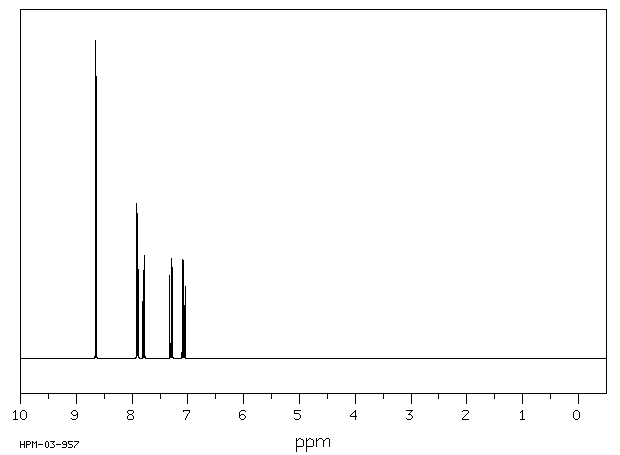1-苯并碲吩 | 272-35-5
中文名称
1-苯并碲吩
中文别名
——
英文名称
benzo[b]tellurophene
英文别名
1-benzotellurophene
CAS
272-35-5
化学式
C8H6Te
mdl
——
分子量
229.736
InChiKey
WDKYOIMDQCVVST-UHFFFAOYSA-N
BEILSTEIN
——
EINECS
——
-
物化性质
-
计算性质
-
ADMET
-
安全信息
-
SDS
-
制备方法与用途
-
上下游信息
-
文献信息
-
表征谱图
-
同类化合物
-
相关功能分类
-
相关结构分类
物化性质
-
熔点:67.5°C
-
沸点:135 °C(Press: 12 Torr)
计算性质
-
辛醇/水分配系数(LogP):1.9
-
重原子数:9
-
可旋转键数:0
-
环数:2.0
-
sp3杂化的碳原子比例:0.0
-
拓扑面积:0
-
氢给体数:0
-
氢受体数:0
SDS
反应信息
-
作为反应物:参考文献:名称:Maercker, Adalbert; Bodenstedt, Heinrich; Brandsma, Lambert, Angewandte Chemie, 1992, vol. 104, # 10, p. 1387 - 1388摘要:DOI:
-
作为产物:参考文献:名称:Synthesis of 1-Benzometalloles Containing Group 14, 15, and 16 Heavier Elements via a Common Dilithiostyrene Intermediate.摘要:第14族(Si、Ge、Sn)、第15族(P、As、Sb、Bi)和第16族(Se、Te)的2-三甲基硅基-1-苯基金属富烯(7)是通过相应的金属试剂与β,o-二锂-β-三甲基硅基苯乙烯中间体(6)反应制备得到的,该中间体(6)是通过苯乙炔或邻溴碘苯经过三步反应衍生而来。7中的三甲基硅基可以通过四丁基氟化铵处理方便地去除,得到C未取代的1-苯基金属富烯(10)。DOI:10.1248/cpb.42.1437
文献信息
-
A versatile synthetic route to 1-benzometalloles involving the first examples of several C-unsubstituted benzometalloles作者:Jyoji Kurita、Makoto Ishii、Shuji Yasuike、Takashi TsuchiyaDOI:10.1039/c39930001309日期:——The group 14 (Si, Ge, Sn), group 15 (P, As, Sb, Bi) and group 16 (S, Se, Te)(2-trimethylsilyl)-1-benzometalloles 5 have been prepared from phenylacetylene via three steps and converted into the corresponding C-unsubstituted benzometalloles 7 by detrimethylsilylation.
-
Regioselective Tandem C–H Alkylation/Coupling Reaction of <i>ortho</i>-Iodophenylethylenes via <i>C</i>,<i>C</i>-Pallada(II)cycles作者:Bin-Bin Zhu、Wen-Bo Ye、Zhi-Tao He、Shu-Sheng Zhang、Chen-Guo Feng、Guo-Qiang LinDOI:10.1021/acscatal.1c03386日期:2021.10.1diorganopalladium species with favorable stability and an electron-rich nature, leading to efficient sequential reactions with diverse electrophiles and nucleophiles. Specifically, the development of aryl-alkenyl-palladacycle-based transformations could provide an attractive approach with regio- and stereocontrol for the construction of multifunctionalized arylethylenes. However, currently, the C,C-pallada(II)cycle五元C , C -钯 (II) 环是一类独特的二有机钯物种,具有良好的稳定性和富电子性,可与不同的亲电子试剂和亲核试剂进行有效的连续反应。具体而言,基于芳基-烯基-钯环的转化的发展可以为构建多功能芳基乙烯提供一种具有区域和立体控制的有吸引力的方法。然而,目前C,C-钯(II)环的形成依赖于骨架中的刚性骨架或空间拥挤来促进环钯化,并且尚未实现没有α-取代基的芳基-烯基-钯环的形成。此外,可以区分两个 sp 的反应这种C (sp 2 )、C (sp 2 )-钯环的2个碳中心仍然难以捉摸。在此,我们报告了一种区域选择性三组分串联烷基化/偶联反应,适用于各种非、α-或 β-取代和 α,β-二取代的邻碘苯基乙烯。富电子 2-吡啶酮配体用于实现环钯化过程,导致芳基-烯基-钯环中间体,其中两个 C-Pd 键因其固有的空间和电子差异而被区分为烷基化。观察到区域/化学选择性和哈米特 σ 值之间良好的线性自由能关系。
-
Toward Novel Antioxidants: Preparation of Dihydrotellurophenes and Selenophenes by Alkyltelluride-Mediated Tandem S<sub>RN</sub>1/S<sub>H</sub>i Reactions<sup>1</sup>作者:Lars Engman、Melissa J. Laws、Jonas Malmström、Carl H. Schiesser、Lisa M. ZugaroDOI:10.1021/jo9907235日期:1999.9.1distributions similar to those observed for reactions involving n-BuTeNa. Lithium or sodium phenyltellurolate returned only starting materials from these reaction mixtures. The 2-[2-(n-butyltelluro)-1-hydroxy-1-methyl]ethylphenyl radical (14) is estimated to cyclize with k(c) = 5 x 10(8) s(-)(1) at 25 degrees C. The tandem S(RN)1/S(H)i sequence has been applied to the preparation of the antioxidant analogues, 5-hydroxy-21-(2-碘苯基)-1-甲基环氧乙烷(12)与2当量的正丁基碲铝酸钠(n-BuTeNa)的反应,是由四氢化二正丁基硼氢化钠在THF中的硼氢化钠还原生成的,得到2, 3-二氢-3-羟基-3-甲基苯并[b] tellurophene(13)的产率为62%,以及少量的1-(n-丁基碲基)-2-苯基-2-丙醇(27)。该转化大概涉及串联的S(RN)1 / S(H)i序列。1-(苄基硒基)-2-苯基-2-丙醇(5a,R = Me)和1-烯丙氧基-2-碘苯(15)的相似反应得到2,3-二氢-3-羟基-3-甲基苯并[b]分别是]硒烯(17,74%)和3-(正丁基碲基)甲基-2,3-二氢苯并[b]呋喃(18,50%)。通过将碲直接插入所需的烷基锂中生成的烷基碲酸锂,碲上的叔丁基或叔丁基或叔丁基取代提供的产物分布与涉及正丁基萘的反应观察到的产物分布相似。苯基碲酸锂或钠仅从这些反应混合物中返回原料。估计2-
-
Ring opening and extrusion of tellurium atoms in the reaction of benzo[b]tellurophene with trinuclear iron, ruthenium and osmium clusters: X-ray crystal structures of [Os2(μ-C8H6Te)(CO)10], [Os4(μ-C8H4)(μ3-Te)(CO11], [Ru(μ-C8H6Te)(CO)6)], [Ru4(μ3-Te)(μ-C8H6)(CO)11] and [Fe2)μ-C8H6Te(CO)6]作者:Alejandro J. Arce、Arquímedes Karam、Ysaura De Sanctis、Rubén Machado、Mario V. Capparelli、Jorge ManzurDOI:10.1016/s0020-1693(96)05153-5日期:1997.1[Os2(μ-C8H6)(CO)6] (3) [Os4μ-C8H6)(μ3-Te(CO)11] (4), which were obtained were obtained from the reaction of [Os3(CO)12] and benzo[b]tellurophene. [Ru3(μ-C8H6)(CO)8)] (5) (X-ray reported previously) [Ru2(μ-C8H6Te)(CO)6] (6), [Ru2(μ-C8H6] (7) and [Ru4(μ3-Te(μ-C8H6)(CO)11] (8) were derived from the reaction of [Ru3(CO)12] and benzo[b]tellurophene; [Fe2(μ-C8H6Te)(CO)6] (9) and [Fe2(μ-C8H6)(CO)6] (10) were obtained摘要三核羰基簇[Fe3(CO)12],[Ru3(CO)12],[Os3(CO)12]和[Os3(CO)10(MeCN)2]在温和条件下与苯并[b]碲二苯醚反应在回流的四氢呋喃中,得到含有开链配体C6H4CHCHTe或片段Te和C8H6作为桥连配体的化合物。分离出以下化合物并进行了表征:[Os3(μ- Te)(CO)10](1),[Os2(μ- Te)(CO)6] [Os2(μ- Te)(CO)6](3 )[Os4μ- )(μ3-Te(CO)11](4)是从[Os3(CO)12]与苯并[b]碲烷反应而获得的。[Ru3(μ- )( CO)8)](5)(先前已报道X射线)[Ru2(μ- Te)(CO)6](6),[Ru2(μ- Te)(7)和[Ru4(μ3-Te(μ) - )(CO)11](8)源自[Ru3(CO)12]与苯并[b]碲二苯酚; [F
-
Effects of heteroatom substitution in conjugated heterocyclic compounds on photovoltaic performance: from sulfur to tellurium作者:Y. S. Park、T. S. Kale、C.-Y. Nam、D. Choi、R. B. GrubbsDOI:10.1039/c4cc01862a日期:——changing the benzochalcogenophene donor groups from benzothiophenes to benzoselenophenes to benzotellurophenes. These molecules show red-shifts in absorption and external quantum efficiency maxima from sulfur to selenium to tellurium. In bulk heterojunction solar cell devices, the benzoselenophene derivative shows a power conversion efficiency as high as 5.8% with PC61BM as the electron acceptor.
表征谱图
-
氢谱1HNMR
-
质谱MS
-
碳谱13CNMR
-
红外IR
-
拉曼Raman
-
峰位数据
-
峰位匹配
-
表征信息
同类化合物
(βS)-β-氨基-4-(4-羟基苯氧基)-3,5-二碘苯甲丙醇
(S,S)-邻甲苯基-DIPAMP
(S)-(-)-7'-〔4(S)-(苄基)恶唑-2-基]-7-二(3,5-二-叔丁基苯基)膦基-2,2',3,3'-四氢-1,1-螺二氢茚
(S)-(+)-5,5'',6,6'',7,7'',8,8''-八氢-3,3''-二叔丁基-1,1''-二-2-萘酚,双钾盐
(S)-盐酸沙丁胺醇
(S)-溴烯醇内酯
(S)-7,7-双[(4S)-(苯基)恶唑-2-基)]-2,2,3,3-四氢-1,1-螺双茚满
(S)-3-(叔丁基)-4-(2,6-二甲氧基苯基)-2,3-二氢苯并[d][1,3]氧磷杂环戊二烯
(S)-2-N-Fmoc-氨基甲基吡咯烷盐酸盐
(S)-2,2'-双[双(3,5-三氟甲基苯基)膦基]-4,4',6,6'-四甲氧基联苯
(S)-1-[3,5-双(三氟甲基)苯基]-3-[1-(二甲基氨基)-3-甲基丁烷-2-基]硫脲
(R)富马酸托特罗定
(R)-(-)-盐酸尼古地平
(R)-(-)-4,12-双(二苯基膦基)[2.2]对环芳烷(1,5环辛二烯)铑(I)四氟硼酸盐
(R)-(+)-7-双(3,5-二叔丁基苯基)膦基7''-[((6-甲基吡啶-2-基甲基)氨基]-2,2'',3,3''-四氢-1,1''-螺双茚满
(R)-(+)-7-双(3,5-二叔丁基苯基)膦基7''-[(4-叔丁基吡啶-2-基甲基)氨基]-2,2'',3,3''-四氢-1,1''-螺双茚满
(R)-(+)-7-双(3,5-二叔丁基苯基)膦基7''-[(3-甲基吡啶-2-基甲基)氨基]-2,2'',3,3''-四氢-1,1''-螺双茚满
(R)-(+)-4,7-双(3,5-二-叔丁基苯基)膦基-7“-[(吡啶-2-基甲基)氨基]-2,2”,3,3'-四氢1,1'-螺二茚满
(R)-7,7-双[(4S)-(苯基)恶唑-2-基)]-2,2,3,3-四氢-1,1-螺双茚满
(R)-3-(叔丁基)-4-(2,6-二苯氧基苯基)-2,3-二氢苯并[d][1,3]氧杂磷杂环戊烯
(R)-3-(叔丁基)-4-(2,6-二异丙氧基苯基)-2,3-二氢苯并[d][1,3]氧杂磷杂环戊烯
(R)-3,3''-双([[1,1''-联苯]-4-基)-[1,1''-联萘]-2,2''-二醇
(R)-2-[((二苯基膦基)甲基]吡咯烷
(R)-2,2'',3,3''-四氢-6,6''-二-9-菲基-1,1''-螺双[1H-茚]-7,7''-二醇
(R)-1-[3,5-双(三氟甲基)苯基]-3-[1-(二甲基氨基)-3-甲基丁烷-2-基]硫脲
(N-(4-甲氧基苯基)-N-甲基-3-(1-哌啶基)丙-2-烯酰胺)
(6,6)-苯基-C61己酸甲酯
(5-溴-2-羟基苯基)-4-氯苯甲酮
(5-溴-2-氯苯基)(4-羟基苯基)甲酮
(5-氧代-3-苯基-2,5-二氢-1,2,3,4-oxatriazol-3-鎓)
(4S,5R)-4-甲基-5-苯基-1,2,3-氧代噻唑烷-2,2-二氧化物-3-羧酸叔丁酯
(4S,5R)-3,3a,8,8a-四氢茚并[1,2-d]-1,2,3-氧杂噻唑-2,2-二氧化物-3-羧酸叔丁酯
(4S,4''S)-2,2''-亚环戊基双[4,5-二氢-4-(苯甲基)恶唑]
(4-溴苯基)-[2-氟-4-[6-[甲基(丙-2-烯基)氨基]己氧基]苯基]甲酮
(4-丁氧基苯甲基)三苯基溴化磷
(3aS,8aR)-2-(吡啶-2-基)-8,8a-二氢-3aH-茚并[1,2-d]恶唑
(3aS,3''aS,8aR,8''aR)-2,2''-环戊二烯双[3a,8a-二氢-8H-茚并[1,2-d]恶唑]
(3aR,8aR)-(-)-4,4,8,8-四(3,5-二甲基苯基)四氢-2,2-二甲基-6-苯基-1,3-二氧戊环[4,5-e]二恶唑磷
(3aR,6aS)-5-氧代六氢环戊基[c]吡咯-2(1H)-羧酸酯
(3S,3aR)-2-(3-氯-4-氰基苯基)-3-环戊基-3,3a,4,5-四氢-2H-苯并[g]吲唑-7-羧酸
(3R,3’’R,4S,4’’S,11bS,11’’bS)-(+)-4,4’’-二叔丁基-4,4’’,5,5’’-四氢-3,3’’-联-3H-二萘酚[2,1-c:1’’,2’’-e]膦(S)-BINAPINE
(3-三苯基甲氨基甲基)吡啶
(3-[(E)-1-氰基-2-乙氧基-2-hydroxyethenyl]-1-氧代-1H-茚-2-甲酰胺)
(2′′-甲基氨基-1,1′′-联苯-2-基)甲烷磺酰基铝(II)二聚体
(2Z)-3-[[(4-氯苯基)氨基]-2-氰基丙烯酸乙酯
(2S,4S)-Fmoc-4-三氟甲基吡咯烷-2-羧酸
(2S,3S,5S)-5-(叔丁氧基甲酰氨基)-2-(N-5-噻唑基-甲氧羰基)氨基-1,6-二苯基-3-羟基己烷
(2S,3R)-3-(叔丁基)-2-(二叔丁基膦基)-4-甲氧基-2,3-二氢苯并[d][1,3]氧杂磷杂戊环
(2S,2''S,3S,3''S)-3,3''-二叔丁基-4,4''-双(2,6-二甲氧基苯基)-2,2'',3,3''-四氢-2,2''-联苯并[d][1,3]氧杂磷杂戊环
(2S,2''S,3S,3''S)-3,3''-二叔丁基-4,4''-二甲氧基-2,2'',3,3''-四氢-2,2''-联苯并[d][1,3]氧杂磷杂戊环








